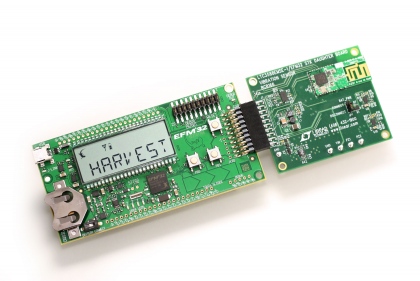- Home»
- News»
- All News Articles»
- New Development Platforms
21 Feb 2012
Any application that relies on a harvestable ambient power source requires careful power management in order to successfully capture the few microwatts of ambient power and store it in an energy storage device where power can be used when needed.
The ambient power source can only supply power in the order of tens of microwatts, while an electronic device usually consumes power in the order of milliwatts. Therefore, the harvested energy must be stored whenever possible, and kept ready to use when needed.
The electronic device must operate at a duty cycle that does not exceed the energy storage. Sometimes this duty cycle can be as low as 0.5%. If for some reason, the ambient power source stops supplying power, the device can usually continue to operate for about 100 hours at the programmed duty cycle, assuming the back-up battery is charged. The power management software should be able to detect this loss of power and prepare for shutdown and display a shutdown message, store data in nonvolatile memory, and other important tasks.
One common form of ambient energy is mechanical vibration energy, which can be caused by motors running, airflow across a fan blade, or even by a moving vehicle. A piezoelectric transducer can be used to convert these forms of vibration energy into electrical energy, which can in turn be stored in an energy reservoir and also be used to power circuitry.
Linear Technology and Energy Micro from Norway have combined their expertise in creating the new EFM Starter Kit, which is a development kit that uses Linear Technology's LTC3588 piezoelectric energy harvesting power supply and Energy Micro's ARM Cortex-M3 enabled EFM32 Gecko microcontroller. This device is a wireless sensor node that acquires data from a 3-axis accelerometer and then transmits it through a Zigbee RF transceiver.

The starter kit’s micro-power 32-bit MCU has a software algorithm that makes certain power measurements at regular intervals to ensure that total circuit consumption stays below harvested energy levels by adjusting the duty cycle and other parameters.
The energy harvested from a piezoelectric transducer is stored on a capacitor bank for later consumption by the accelerometer and radio according to the MCU's optimized sequencing software. The MCU spends the majority of its time in sleep mode until woken by the LTC3588's 'power good' signal.
To manage the energy harvesting and the distribution of energy, the LTC 3588-1 piezoelectric energy harvesting power supply integrates a low loss internal bridge rectifier with a synchronous step-down DC/DC converter. It is designed with an efficient energy harvesting algorithm to collect and store energy from high impedance piezoelectric elements.
The device enters an ultralow quiescent current under-voltage lockout (UVLO) mode with a wide hysteresis window which allows charge to accumulate on an input capacitor until the internal buck converter can efficiently transfer a portion of the stored charge to the output.
Four output voltages, 1.8V, 2.5V, 3.3V and 3.6V, are pin selectable with up to 100mA of continuous output current. The output capacitor may be sized to provide higher output current bursts. An input protective shunt set at 20V enables greater energy storage for a given amount of input capacitance.
